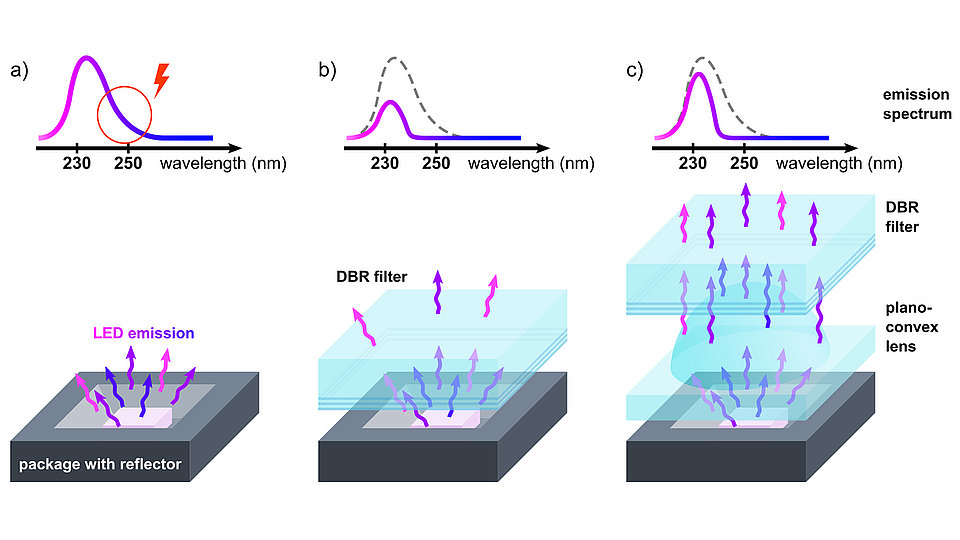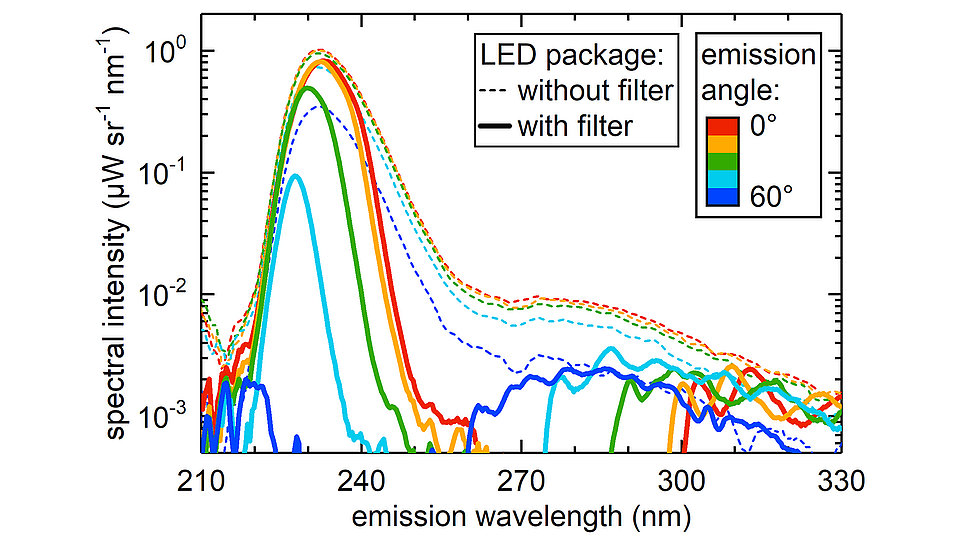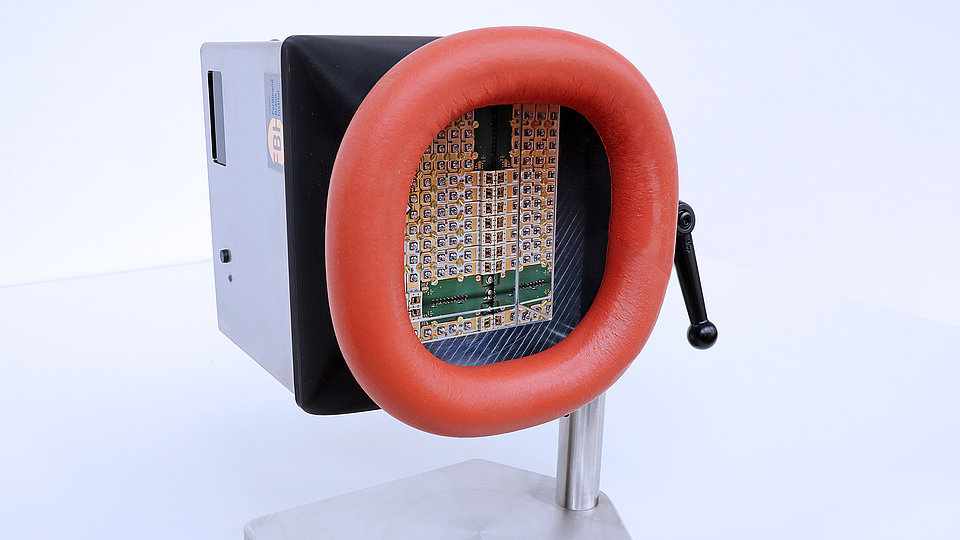Spectrally pure far-UVC LEDs for skin-tolerant UV antisepsis
Fig. 1: Influence of the filter on the emitted spectrum of flip-chip mounted far-UVC LEDs in a package (a) without filter, (b) with a DBR filter lid, and (c) with a plano-convex lens and an additional DBR filter plate.
Fig. 2: Angle-dependent emission spectra of far-UVC LEDs without (dashed lines) and with (solid lines) a DBR filter lid for various polar emission angles between 0° (normal to the package plane) and 60°.
AlGaN-based ultraviolet-C (UVC) light-emitting diodes (LEDs) with an emission wavelength below 240 nm (far-UVC) are highly attractive for applications like gas sensing and disinfection. In collaboration with our partners from Technische Universität (TU) Berlin, Charité – Universitätsmedizin Berlin and Universitätsmedizin Greifswald, we have demonstrated that far-UVC LEDs can be used to inactivate multi-resistant pathogens with minimum damage to animal as well as human skin [1, 2]. Due to the spectral width of the LED emission, spectral filters are required in order to reduce the skin-damaging long-wavelength UVC contribution (Figs. 1a & 1b). However, the emission of the UVC LEDs over a wide angular range leads to a preferentially inclined transmission through the filter. This effect, together with the angle-dependent shift of the cut-off wavelength of the distributed Bragg reflector (DBR) filter, limits the far-UVC emission power that can ultimately be used (Fig. 1b).
In collaboration with TU Berlin and CiS Forschungsinstitut we have now developed a sophisticated chip packaging concept that allows us to better utilize the radiation power of the LEDs. The concept uses a Si-based package with an integrated aluminum reflector and an additional plano-convex lens to spatially narrow the LED emission and increase the transmission through the filter (Fig. 1c) [3]. We investigated the angle-dependent emission spectra of far-UVC LEDs without and with a DBR filter in front of the LED package (Fig. 2). Without filter, the emission spectrum of the LED is independent of the emission angle. An additional filter in front of the LED successfully reduces the contributions at long wavelengths (> 245 nm) by almost two orders of magnitude. However, the power at the peak emission wavelength of 233 nm also decreases for emission angles larger than 30°. This issue was addressed by using a plano-convex lens of parabolic shape to narrow the LED far field before passing the filter. An almost doubled transmission through the filter could be achieved with this concept, resulting in an irradiance of 0.37 mW/cm2 at a distance of 5 cm for an irradiation system with 120 LEDs on an area of 8 cm × 8 cm (Fig. 3).
Our partners from the medical field have used this system to successfully eradicate multiple resistant organisms (MROs) by 5 log10 levels at a dose of 40 mJ/cm², while no serious DNA damages occurred when excised human skin was irradiated with the same dose [2]. These results enabled the start of in-vivo experiments on humans, which are currently underway.
This research was funded by the German Federal Ministry of Education and Research (BMBF) within the ‘Advanced UV for life –VIMRE’ (08/2019–03/2022) and ‘CORSA’ (01/2021–12/2023) projects under the contracts 03ZZ0146C, 03ZZ0146D, 03COV10D, and 03COV10E.
Publications
[1] J. Glaab, N. Lobo-Ploch, H. K. Cho, T. Filler, H. Gundlach, M. Guttmann, S. Hagedorn, S. B. Lohan, F. Mehnke, J. Schleusener, C. Sicher, L. Sulmoni, T. Wernicke, L. Wittenbecher, U. Woggon, P. Zwicker, A. Kramer, M. C. Meinke, M. Kneissl, M. Weyers, U. Winterwerber, S. Einfeldt, “Skin tolerant inactivation of multiresistant pathogens using far-UVC LEDs”, Scientific Reports 11, 14647 (2021).
[2] P. Zwicker, J. Schleusener, S. B. Lohan, L. Busch, C. Sicher, S. Einfeldt, M. Kneissl, A. A. Kühl, C. M. Keck, C. Witzel, A. Kramer, M. C. Meinke, “Application of 233 nm far‑UVC LEDs for eradication of MRSA and MSSA and risk assessment on skin models”, Scientific Reports 12, 2587 (2022).
[3] M. Guttmann, N. Lobo-Ploch, H. Gundlach, F. Mehnke, L. Sulmoni, T. Wernicke, H. K. Cho, K. Hilbrich, A. Külberg, M. Friedler, T. Filler, I. Käpplinger, D. Mitrenga, C. Maier, O. Brodersen, T. Ortlepp, U. Woggon, S. Einfeldt, M. Kneissl, “Spectrally pure far-UVC emission from AlGaN-based LEDs with dielectric band pass filters”, J. Phys. D: Appl. Phys. 55, 205105 (2022).
[4] J. Glaab, J. Ruschel, N. Lobo Ploch, H.K. Cho, F. Mehnke, L. Sulmoni, M. Guttmann, T. Wernicke, M. Weyers, S. Einfeldt, and M. Kneissl, “Impact of operation parameters on the degradation of 233 nm AlGaN-based far-UVC LEDs”, J. Appl. Phys. 131, 014501 (2022).


